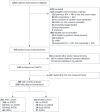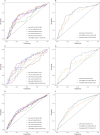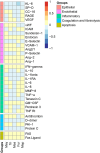Breath metabolomics for diagnosis of acute respiratory distress syndrome
- PMID: 38521944
- PMCID: PMC10960461
- DOI: 10.1186/s13054-024-04882-7
Breath metabolomics for diagnosis of acute respiratory distress syndrome
Abstract
Background: Acute respiratory distress syndrome (ARDS) poses challenges in early identification. Exhaled breath contains metabolites reflective of pulmonary inflammation.
Aim: To evaluate the diagnostic accuracy of breath metabolites for ARDS in invasively ventilated intensive care unit (ICU) patients.
Methods: This two-center observational study included critically ill patients receiving invasive ventilation. Gas chromatography and mass spectrometry (GC-MS) was used to quantify the exhaled metabolites. The Berlin definition of ARDS was assessed by three experts to categorize all patients into "certain ARDS", "certain no ARDS" and "uncertain ARDS" groups. The patients with "certain" labels from one hospital formed the derivation cohort used to train a classifier built based on the five most significant breath metabolites. The diagnostic accuracy of the classifier was assessed in all patients from the second hospital and combined with the lung injury prediction score (LIPS).
Results: A total of 499 patients were included in this study. Three hundred fifty-seven patients were included in the derivation cohort (60 with certain ARDS; 17%), and 142 patients in the validation cohort (47 with certain ARDS; 33%). The metabolites 1-methylpyrrole, 1,3,5-trifluorobenzene, methoxyacetic acid, 2-methylfuran and 2-methyl-1-propanol were included in the classifier. The classifier had an area under the receiver operating characteristics curve (AUROCC) of 0.71 (CI 0.63-0.78) in the derivation cohort and 0.63 (CI 0.52-0.74) in the validation cohort. Combining the breath test with the LIPS does not significantly enhance the diagnostic performance.
Conclusion: An exhaled breath metabolomics-based classifier has moderate diagnostic accuracy for ARDS but was not sufficiently accurate for clinical use, even after combination with a clinical prediction score.
Keywords: ARDS; Breath analysis; Prediction model; VOCs.
© 2024. The Author(s).
Conflict of interest statement
Summary conflict of interest statements: LDJB reports grants from: Dutch lung foundation (Dirkje Postma Award), Innovation Medicine Initiative (COVID-19 call), grants from Amsterdam UMC fellowship, Health Holland via lung foundation (PPP grant) and ZonMW (VIDI, COVID-19 urgency grants). LDJB reports participating in an advisory board for Sobi, Impentri, Novartis, CSL Behring and Astra Zeneca, all paid to institution. LDJB reports consultancy for Scailyte, who paid to institution, outside the submitted work. PB reports grants from: Amsterdam UMC (Innovation Impuls 2020 Grant), Vertex (Vertex Innovation Award 2022 Grant), Stichting Astma Bestrijding (SAB) Grant, Boehringer Ingelheim Grant, Eurostars, Horizon Europe Framework Programme (HORIZON) Grant. RS reports grant from: Dutch lung foundation (Young investigator grant). LAH, NFLH, MRS, DWF, MJS, DCJJB, and TvdP have no conflict of interest regarding this manuscript.
Figures



References
Publication types
MeSH terms
Grants and funding
LinkOut - more resources
Full Text Sources
Medical
Miscellaneous

